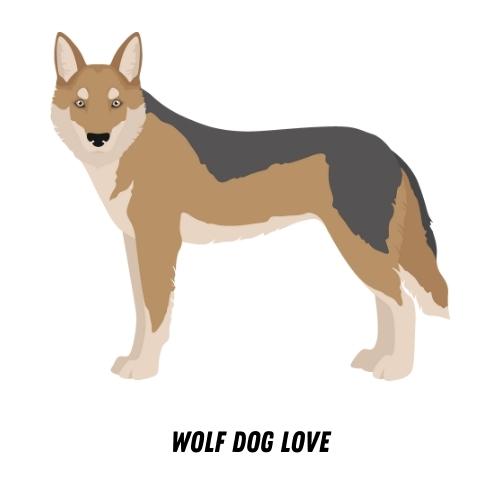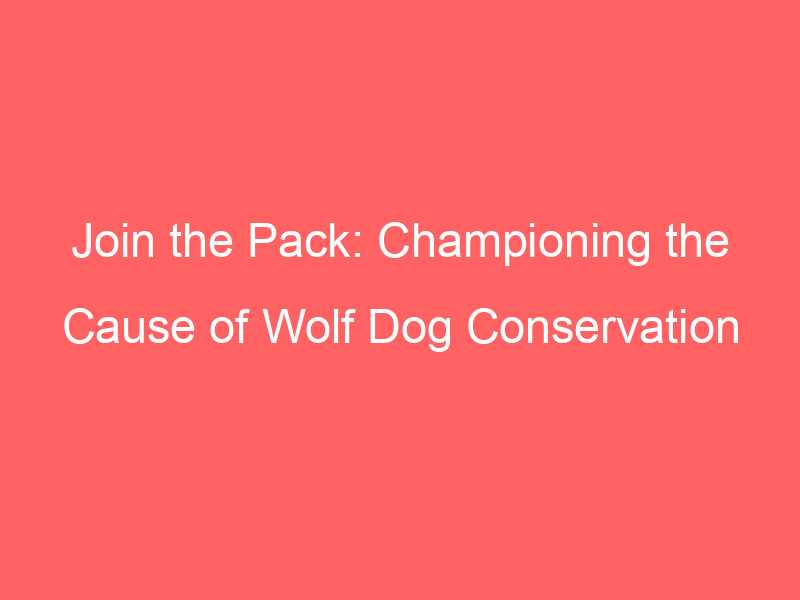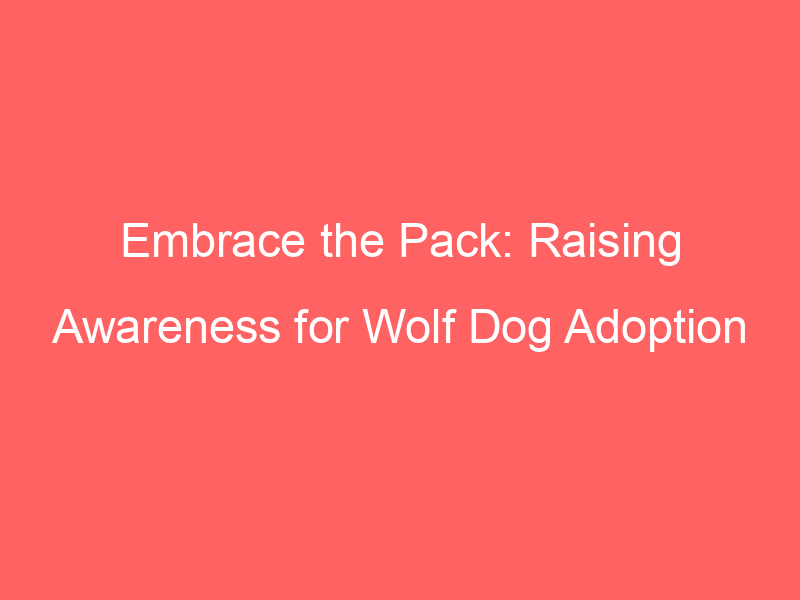Introduction to Wolf Dog Conservation
Wolf dogs, a unique breed that combines the traits of wolves and domestic dogs, are fascinating creatures. Their survival, however, is under threat. This is why we need to talk about Wolf Dog Conservation. This introductory section will help you understand the importance of Wolf Dog Conservation and the current state of Wolf Dog species.
- Understanding the Importance of Wolf Dog Conservation
- Current State of Wolf Dog Species
Wolf dogs are a vital part of our ecosystem. They play a significant role in maintaining the balance of nature. However, due to various factors like habitat loss, hunting, and disease, their numbers are dwindling. It’s important to conserve these species not only for their survival but also for the overall health of our environment.
Conservation efforts help protect the genetic diversity of wolf dogs. This diversity is crucial for the species’ ability to adapt to changing environments and to resist diseases. Moreover, wolf dogs have cultural and historical significance in many societies. Their conservation is a way of preserving these cultural heritages.
The current state of wolf dogs is concerning. According to the International Union for Conservation of Nature (IUCN), many wolf dog populations are at risk. Some are even on the brink of extinction.
One of the main reasons for this decline is habitat loss. As human populations grow and expand, wolf dogs are losing their natural habitats. This forces them into conflict with humans, often leading to their death. Disease and hunting are other significant threats to these species.
Despite these challenges, there are reasons for hope. Many dedicated organizations and individuals are working tirelessly to conserve wolf dogs. They are implementing various strategies, such as habitat protection, captive breeding, and public education, to ensure the survival of these magnificent creatures.
Wolf Dog Protection: The Need of the Hour
Wolf dogs, a unique blend of domestic dog and wild wolf, face numerous threats. Their survival is at risk, making their protection a pressing concern. Let’s delve into the challenges they face and why their protection is the need of the hour.
Threats to Wolf Dog Survival
Several factors threaten the survival of wolf dogs. Here are the top three:
- Loss of Habitat
- Illegal Hunting
- Climate Change
Wolf dogs require large territories to thrive. However, rapid urbanization and deforestation have led to a significant loss of their natural habitat. This not only reduces their roaming space but also limits their access to food and shelter.
Despite laws against it, illegal hunting of wolf dogs is a grim reality. Some people hunt them for their unique fur, while others do it out of fear or misunderstanding. This illegal activity severely affects their population.
Climate change is another major threat. Rising temperatures, melting ice caps, and unpredictable weather patterns disrupt the ecosystems where wolf dogs live. This can lead to a scarcity of food and increased competition for resources.
These threats highlight the urgent need for wolf dog protection. It’s our responsibility to ensure these magnificent creatures continue to thrive. In the next section, we’ll discuss how we can advocate for their protection and contribute to their survival.
Advocacy for Wolf Dogs: A Call to Action
Wolf dogs, a unique blend of domestic dog and wild wolf, are fascinating creatures. They are often misunderstood and mistreated due to lack of knowledge and legal protection. This is where the role of advocacy groups becomes crucial. They work tirelessly to protect these beautiful animals and ensure their survival.
Role of Wolf Dog Advocacy Groups
Wolf dog advocacy groups play a significant role in the conservation of these unique animals. They are involved in a variety of activities, two of which are particularly noteworthy:
- Creating awareness about Wolf Dog Conservation
- Fighting for legal protection for Wolf Dogs
Advocacy groups work to educate the public about wolf dogs. They dispel myths and misconceptions, and provide accurate information about their behavior, needs, and the challenges they face. They organize events, workshops, and campaigns to reach as many people as possible. By doing so, they hope to foster a better understanding and appreciation for wolf dogs, which can lead to better treatment and care for these animals.
Wolf dogs often fall into a legal gray area. They are not fully protected as wild animals, and yet they are not given the same rights as domestic dogs. Advocacy groups lobby for laws and regulations that recognize the unique status of wolf dogs and provide them with the protection they need. This includes laws that regulate breeding, ownership, and treatment of wolf dogs, as well as laws that protect their habitats.
Through their tireless efforts, wolf dog advocacy groups are making a difference in the lives of these animals. They are a voice for the voiceless, standing up for those who cannot stand up for themselves. Their work is a call to action for all of us to do our part in protecting and preserving these unique creatures.
Remember, every action counts. Even small steps can make a big difference. So, join the pack, lend your voice, and help make a difference for wolf dogs today.
Wolf Dog Species Preservation: Conservation Efforts
Preserving the wolf dog species is a crucial task that requires collective efforts. Conservation strategies are being implemented to ensure the survival of these majestic creatures. Let’s delve into some of these efforts, particularly focusing on protecting their habitats.
Protecting Wolf Dog Habitats
Wolf dogs, like all creatures, need a safe and healthy environment to thrive. Their habitats are under threat due to various human activities. Two significant steps in habitat protection are establishing protected areas and restoring damaged habitats.
- Establishing Protected Areas
One of the primary strategies for preserving wolf dog species is by establishing protected areas. These are specific regions where human activities are limited or regulated to prevent habitat destruction. For instance, Yellowstone National Park in the United States is a well-known protected area where wolf dogs can live and breed without disturbance.
- Restoring Damaged Habitats
Restoring damaged habitats is another crucial step in conservation efforts. This involves repairing areas that have been destroyed or altered due to human activities, such as deforestation or pollution. For example, reforestation projects can help restore the natural balance of the ecosystem, providing wolf dogs with the resources they need to survive.
By understanding and supporting these conservation efforts, we can all contribute to the preservation of the wolf dog species. Remember, every effort counts when it comes to conservation. Let’s join hands to ensure the survival of these magnificent creatures and the preservation of our planet’s biodiversity.
| Conservation Strategy | Description |
|---|---|
| Establishing Protected Areas | Designating specific regions where human activities are limited or regulated to prevent habitat destruction. |
| Restoring Damaged Habitats | Repairing areas that have been destroyed or altered due to human activities, such as deforestation or pollution. |
Wolf Dog Survival Efforts: The Road Ahead
As we look to the future, the survival of wolf dogs is a concern that requires our attention. The road ahead is filled with challenges, but with concerted efforts, we can make a difference. Let’s explore some of the key conservation programs that are paving the way for wolf dog survival.
Wolf Dog Conservation Programs
There are two main types of programs that have been instrumental in wolf dog conservation. These are:
- Reintroduction programs
- Monitoring and research
Reintroduction programs aim to increase the population of wolf dogs in the wild. These programs involve breeding wolf dogs in controlled environments and then releasing them into their natural habitats. For example, the Yellowstone National Park in the United States has seen a significant increase in its wolf dog population thanks to a successful reintroduction program.
Monitoring and research programs are crucial for understanding the needs and behaviors of wolf dogs. These programs involve tracking wolf dogs in the wild, studying their habits, and collecting data to inform conservation strategies. For instance, research has shown that wolf dogs play a crucial role in maintaining the balance of ecosystems by controlling the population of other animals.
These conservation programs are making a significant difference in the survival of wolf dogs. However, there is still much work to be done. The road ahead may be challenging, but with continued efforts, we can ensure a bright future for these magnificent creatures.
Conclusion: Join the Pack
As we wrap up our discussion on Wolf Dog conservation, it’s important to remember that each one of us can play a significant role in protecting these magnificent creatures. Let’s explore how you can contribute and what the future holds for Wolf Dog protection.
- How individuals can contribute to Wolf Dog Conservation
- The future of Wolf Dog Protection
There are many ways you can help in the conservation of Wolf Dogs. First, you can support organizations that are dedicated to the protection and preservation of these animals. These groups work tirelessly to rescue, rehabilitate, and provide sanctuary for Wolf Dogs.
Secondly, educating yourself and others about Wolf Dogs is crucial. The more people understand about these animals, the better they can help protect them. You can do this by reading books, attending seminars, or even hosting a local event to raise awareness.
Lastly, adopting a Wolf Dog from a rescue or shelter can give these animals a second chance at life. Remember, adoption should be a lifelong commitment and requires careful consideration.
The future of Wolf Dog protection is promising, but it requires continuous effort from all of us. With increased awareness and support, more resources can be dedicated to the rescue and rehabilitation of these animals.
Scientific research and advancements in technology are also playing a significant role in Wolf Dog conservation. For instance, DNA testing is now being used to accurately identify Wolf Dogs, which helps in their protection and management.
Furthermore, laws and regulations protecting Wolf Dogs are becoming more stringent, which is a positive step towards their survival. However, enforcement of these laws is equally important.
In conclusion, joining the pack means becoming a part of the solution. It means standing up for Wolf Dogs and doing our part to ensure their survival. Remember, every little bit helps. So, let’s join the pack and make a difference for Wolf Dogs today!








